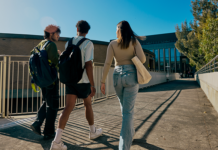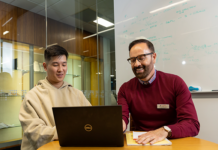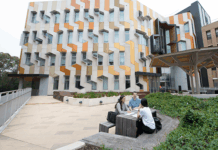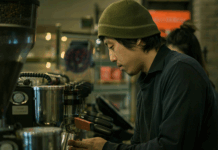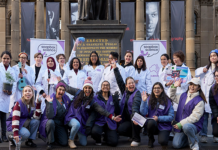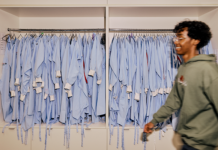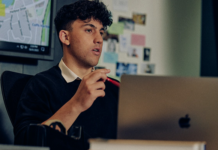La Trobe University expects members of our community to uphold our values and goals in fostering a safe, respectful, and inclusive community.
In a study by VicHealth and Victoria University, 78% of students said they would intervene if they saw something unacceptable happen on campus.
It is important that we call out concerning behaviour every time we see it. So, we’ve created a 5-part series on bystander action to help you educate yourself and others to be active bystanders.
“Active bystander: Someone who responds to the incident with some action that communicates their disapproval” VicHealth. 2019
Look out over the next few weeks for topics on sexual harm, sexist jokes and comments, online abuse and inappropriate sexual advances and contact to learn how it can happen on campus and what you can do to help.
Topic 1: Sexual harm. What does it look like on campus? How can I help?
What is Sexual Harm?
Sexual harm is defined by the University as any behaviour of a sexual nature including:
- sexual assault
- rape
- sexual harassment
- other sexual behaviours that:
- makes someone feel uncomfortable, frightened, intimidated, threatened or coerced
- a person has not agreed to participate in, either in person or online
- a person has not clearly indicated ‘affirmative consent’ or is not capable of consenting.
Sexual harm can happen to anyone and can happen anywhere. Sexual harm can be a traumatic experience that can have a range of negative impacts, including shock, denial, fear, anxiety, and depression. It is important to remember, sexual harm is never the fault of the victim.
Sexual harm is against the law. Everyone has the right to feel safe. If you or someone you know experiences sexual harm you can seek support. Keep reading to find out about support you can access at the University.
What does sexual harm look like on campus?
Sexual Harm can look like many things. Part of being an active bystander is having the knowledge to recognise it. Here are some examples:
| Example 1 | While walking on campus you overhear a student following and repeatedly asking another student out, you hear them say no repeatedly and they look uncomfortable. |
| Example 2 | You are at a university event; students are drinking and dancing. You notice a guy come up behind a student on the dancefloor and start touching her and grabbing her hips. |
| Example 3 | You are in the lunchroom with your friends and a group of students nearby start making sexual gestures and comments to one of your friends that’s sitting with you. You try to ignore the comments but you see that your friend is upset. |
| Example 4 | A student in a Zoom class changes their name to a sexually explicit comment. |
Here’s what you can do
AIDED Model for Bystander Action
We use the AIDED Model of Bystander Action at La Trobe University. The AIDED model was created to help bystanders form strategies when they witness a situation. It aims to help the bystander decide how they may help.
You can view more of AIDED and bystander action on your LMS, Module 7 of Respectful Behaviour and Culture.
If you witness or experience any of the above examples on campus, use AIDED to choose what strategy would be most appropriate. Often there are many strategies you can use, depending on your level of confidence and the appropriateness of the situation.
| AIDED | What to do? |
| A – Assign | Assign responsibility of the incident to another person. For example, call emergency services, or ask a friend of the perpetrator to intervene. You can also contact Security while on campus, 03 9479 2222. |
| I – Indirect | Intervene indirectly by getting help from someone that knows the parties involved in the incident. You can also intervene indirectly by checking in with the victim later and providing them with support and assistance. |
| D – Direct | Directly intervene by stepping in, stopping |
| E – Evidence | Keep a record of the incident, such as taking a video or screenshots of online sexual harm, or writing down some notes about the time and place of an incident. |
| D – Divert | Divert the harm away from the target by distracting the perpetrator’s attention. An example is asking the perpetrator to go for a walk, taking them away from the victim, or causing a distraction to divert their attention. |
| Example 1 | I, Indirect – Check in with the student afterwards and see if they need further support. D, Direct – Step in if safe to do so and support the student in saying no. |
| Example 2 | A, Assign – Call security (if available) and report the guy. Call police if further action is necessary. I, Indirect – Support the student to see if she needs further help. D, Divert – Distract the perpetrator to give the victim time to get away. Say “Hey, let’s go get a drink”. |
| Example 3 | I, Indirect – Ask if your friend is ok and if she wants to get further support or report the incident. D, Direct – If safe to do so, ask the person, “why are you doing that?”. Or say to that person “Hey, this is inappropriate and unwanted”. |
| Example 4 | A, Assign – Let your supervisor know what has occurred in private. E, Evidence – Keep a snapshot of the incident. |
Reporting and disclosing within the University
La Trobe has a variety of safety and security options you can contact depending on your situation, both on and off-campus. For a full list of extensive services, have a look at this article.
In circumstances of sexual harm, or any unacceptable behaviour, consider the following options.
In an Emergency
- Call police or emergency services – (24 hours) Triple Zero ‘000’
- If on-campus then call Campus Security – (24 hours) 03 9479 8888. They need to be aware of the incident to let emergency services on campus if required and can assist until their arrival.
Safer Community
Contact Safer Community to disclose or report an incident.
It is a free, confidential support service you can contact if you experience or witness concerning, threatening, inappropriate or uncomfortable behaviour. This behaviour can occur on-campus and off-campus, such as on public transport or in the home.
Safer Community provides expert advice and information. They also offer you options and referrals to help resolve your concerns to keep you and others safe.
*Refer to Safer Community website for a full privacy and confidentiality statement and limitations.
Professor Jessica Vanderlelie
Deputy Vice-Chancellor (Students)
